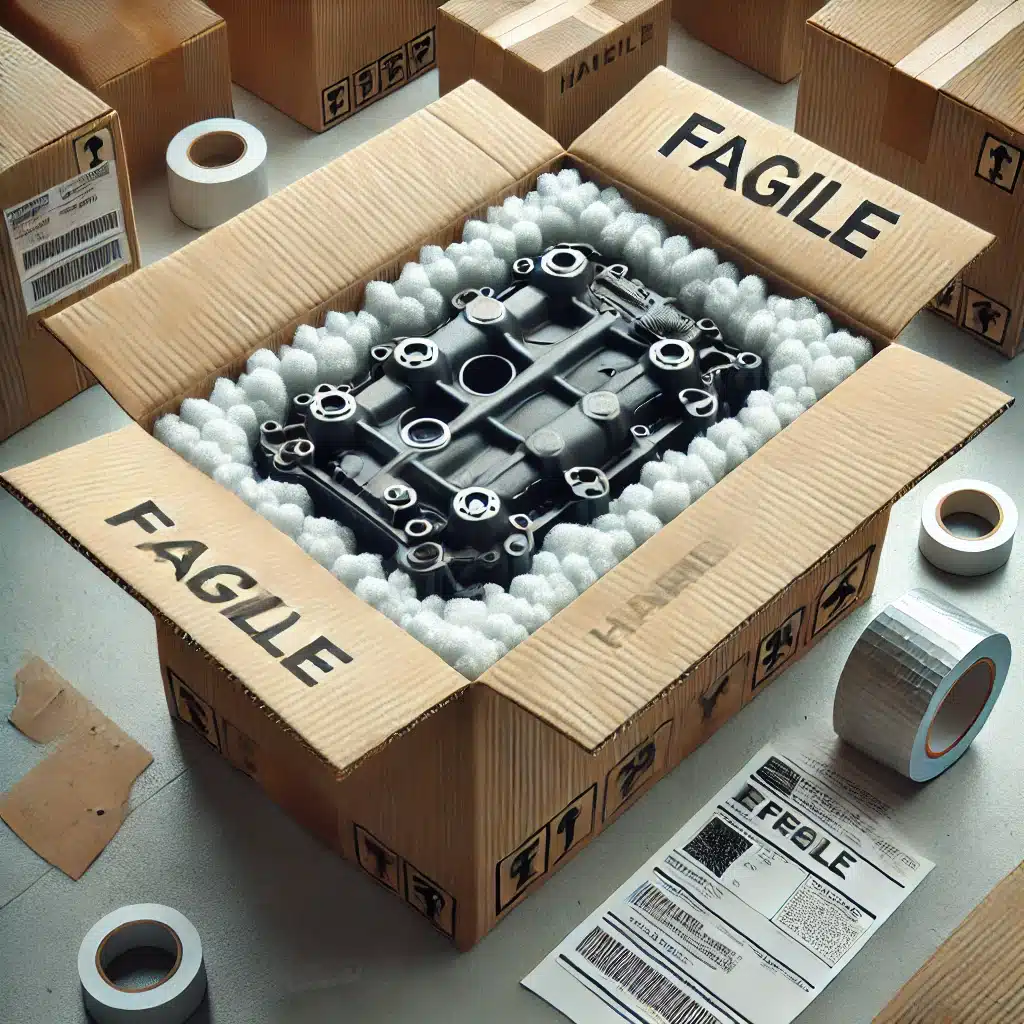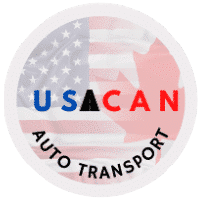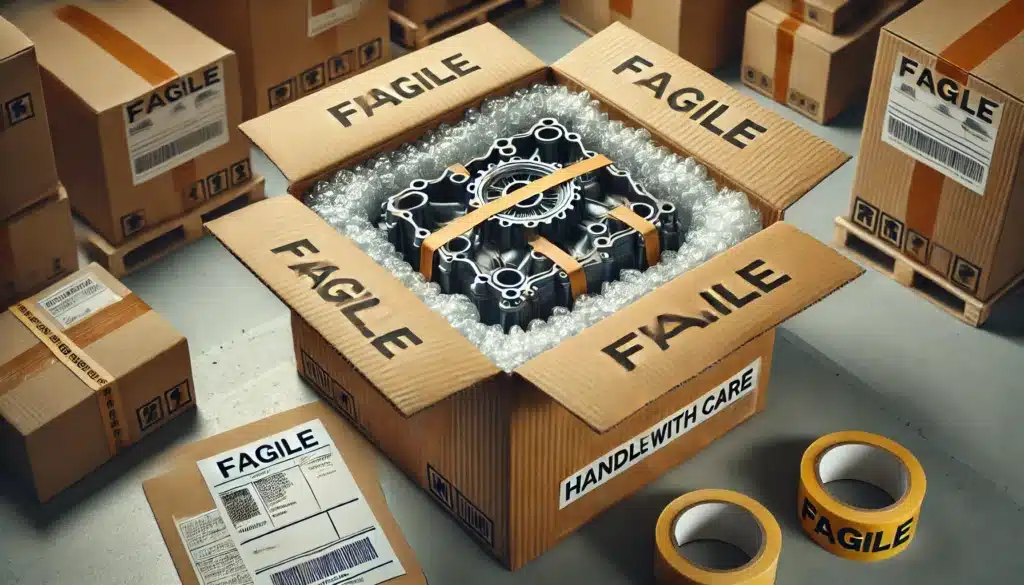What are the packaging best practices for safe auto parts shipping? That is a question that you may find yourself asking when it comes to the transportation of car parts both locally and to another country. We have previously written an article in which we showed you how to ship car parts to Canada from the US. Perhaps you are in that situation. Car parts can be heavy and delicate, and they need to be handled properly, lest they arrive at their final destination damaged.
There has recently been talk of tariffs by US President Donald Trump on Canadian goods. Initially the tariffs were deferred, but the US President remains adamant that they will go ahead at the end of the day. The auto industry will likely be hugely affected in this regard. That’s because of the level of integration between the industries in the two countries.
US and Canadian Auto Industries are Highly Integrated
The movement of auto parts between Canada and the United States happens countless times every day. It’s a vital element of the automotive industry, facilitating maintenance, repairs, and customizations across borders. Ensuring that these parts arrive safely and intact requires meticulous attention to packaging and an understanding of cross-border shipping dynamics.
Not only is it done on an industrial scale, but individuals also routinely buy and ship car parts from across the border. This comprehensive guide is mostly focused on this type of shipment. We show you the best packaging practices, the frequency of cross-border auto parts shipments, and the potential impact of recent tariffs on shipments. The goal is to ensure that your car parts arrive at their destination without suffering any damage.
Best Packaging Tips for Auto Parts Shipping
So, how do you package your auto parts so they arrive where they are going safely? Remember car parts can be heavy and unwieldy. Packaging them properly is important is an art that, fortunately, anyone can master with a little bit of time and effort. Here are essential packaging best practices for safe auto parts shipping;
1. Clean and prepare the parts
Before packaging, thoroughly clean each auto part to remove dirt, grease, and oil. Contaminants can cause damage during shipping and may compromise the integrity of packaging materials. Clean parts also facilitate easier handling and inspection upon arrival.
2. Select appropriate packaging materials
Next, you need to choose the appropriate packaging materials to ensure that the parts that you are shipping are not damaged and they do not cause damage to other goods while in transit. Check out the video in the next section of this article. You can see that the person in it used Styrofoam to protect the parts they were shipping. The following are some of the packaging materials that you can choose for your car parts;
- Boxes: You need to get sturdy, corrugated cardboard boxes that can support the weight of the part that you wish to ship. Ensure the box size accommodates the part with sufficient space for cushioning materials.
- Cushioning: Employ materials such as bubble wrap, foam padding, or packing peanuts to cushion the part. Ensure all protrusions and delicate components are well-protected to prevent movement and abrasion.
- Wrapping: For parts with sharp edges or irregular shapes, wrap them in heavy-duty plastic or protective covers to prevent damage to the part and the packaging.
3. Secure the Package
Once you have cleaned the parts and acquired the necessary packaging materials, the next step involves securing the package. You can do so in the following ways;
- Immobilization: Place the cushioned part in the center of the box, ensuring it doesn’t touch the box’s sides. Fill any voids with additional cushioning to immobilize the part. It’s very important to ensure that the parts do not move freely in their packaging. That’s the reason why we emphasised getting the correct type of packaging materials at the right size.
- Sealing: Use high-quality packing tape to seal all seams and edges of the box securely. Reinforce corners and stress points to enhance the box’s integrity. In fact, you should probably wrap around the tape several times just to be sure everything is secure. That’s particularly the case for heavy parts.
- Labeling: Clearly label the package with handling instructions such as “Fragile,” “This Side Up,” or “Heavy.” Include complete shipping and return addresses, and ensure labels are affixed on the top surface of the box for visibility.
4. Special Considerations for Hazardous Materials
Certain auto parts, like batteries or components containing fluids, are classified as hazardous materials. This classification includes lithium batteries, which may not have fluids in them. They are still considered to be highly dangerous items due to the risk of fire if proper care is not taken in their shipment. Here are the regulations for transporting batteries for Canada. When shipping hazardous items:
- Drain Fluids: Where applicable, you need to drain any fluids to prevent leaks and potential hazards.
- Comply with Regulations: Adhere to shipping regulations for hazardous materials, which may include using specific packaging, labeling, and documentation. For instance, the U.S. Department of Transportation and the Federal Aviation Administration have stringent requirements for shipping such items.
Why Would Someone Ship Auto Parts?

Those are the best practices for packaging auto parts for shipping. In this section, we take a look at some of the reasons why people end up having to ship parts for their vehicle. In this article, we are focused on shipments that are made across the US, Canada border, but the tips that are given here can be helpful to anyone.
Shipping auto parts is a common necessity for businesses and individuals alike. Whether you’re a mechanic, a car enthusiast, or someone in need of a hard-to-find replacement part, there are several reasons why you might need to ship auto parts across cities, states, or even international borders.
1. Replacement Parts for Repairs
When a car breaks down, getting the right replacement part quickly is crucial. Many auto repair shops and individuals order parts from other regions or countries, especially if the part is not available locally.
2. Classic Car Restorations
Restoring vintage and classic cars often requires rare or discontinued parts. Collectors and restoration experts frequently source these parts from specialty sellers, junkyards, or private sellers, requiring shipping to complete their projects. If you are in this situation, you could find yourself having to ship the parts from one end of the country to another.
3. Performance Upgrades and Customization
Car enthusiasts looking to enhance their vehicle’s performance often purchase aftermarket parts such as turbochargers, exhaust systems, or suspension kits from specialty manufacturers, which may be located overseas or in another part of the country.
4. Resale and E-Commerce
Many businesses and individual sellers ship auto parts as part of the booming online marketplace. Platforms like eBay, Amazon, and specialty auto part retailers cater to customers worldwide, making efficient shipping essential.
5. Cross-Border Trade Between the U.S. and Canada
The U.S. and Canada share a strong automotive trade relationship, with millions of parts being shipped between the two countries annually. Whether it’s manufacturers sourcing components, dealerships fulfilling customer orders, or individuals buying parts, cross-border shipping plays a huge role in the industry.
5. Having the parts rebuild
Below we share a video from YouTube channel 605BOLT. The clip is about packaging heavy parts for shipment. Also of interest to us here is that the narrator states that they are shipping their parts to have them rebuild. That’s another of the reasons why people tend to look for packaging tips for auto parts.
Will Tariffs affect cross border car shipments?
Trade policies and tariffs can significantly influence the cost and logistics of shipping auto parts between Canada and the United States. Recent tariffs introduced by President Trump have affected various sectors, including the automotive industry. So, this is something that you need to keep in mind when it comes to transporting your car parts across the border. These tariffs can lead to:
- Increased Costs: Tariffs may raise the cost of importing and exporting auto parts, affecting manufacturers, retailers, and consumers. Businesses might face higher expenses, which could be passed down the supply chain.
- Supply Chain Adjustments: Companies may need to reassess their supply chains, seeking alternative suppliers or adjusting sourcing strategies to mitigate tariff impacts.
- Regulatory Changes: Tariffs often come with changes in trade regulations, requiring businesses to stay informed and compliant to avoid penalties and delays.
It’s crucial for businesses involved in cross-border auto parts shipping to monitor trade policies continually. Consulting with trade experts and leveraging resources from customs agencies can provide guidance on navigating these changes effectively.
Now you know what to do
Shipping auto parts between Canada and the United States requires careful packaging to ensure parts arrive safely and in optimal condition. In this article, we covered packaging best practices for safe auto parts shipping. The most important element is to ensure that the parts are packaged properly. This can be done using a wide range of materials. In case the parts contain hazardous materials, extra care is needed to ensure that you do not fall foul of regulations.

